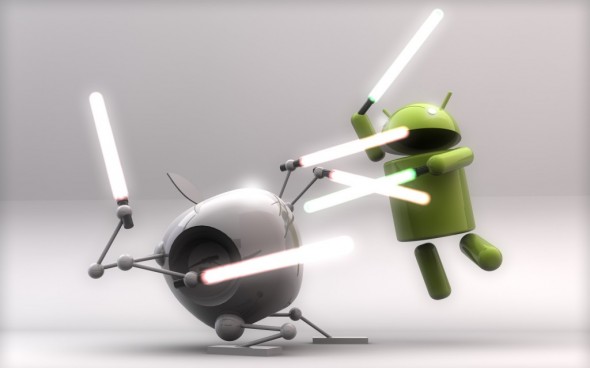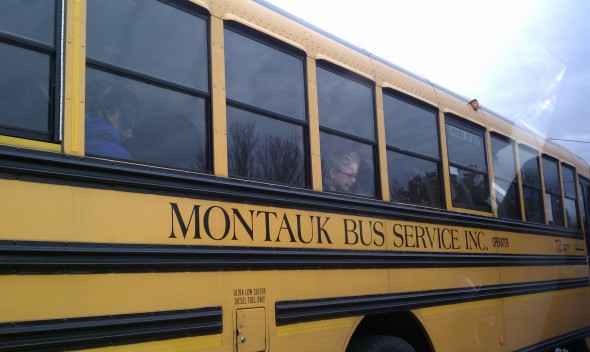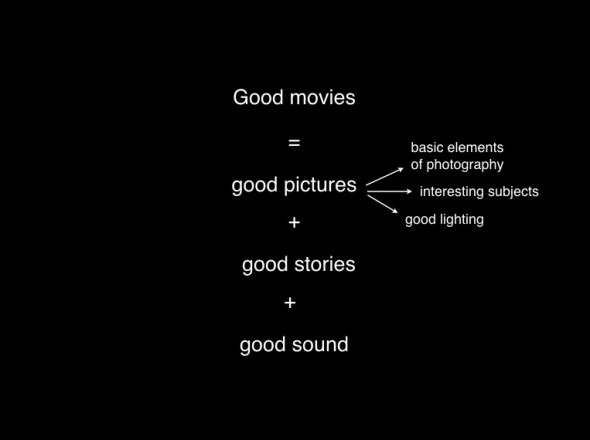Video
Google Android OS is bad, and Apple iOS is awesome. Really? Read this first and then let’s talk.
UPDATED: Jan 07, 2012. According to The Daily Beast (via Engadget) Apple’s co-founder Steve Wozniak prefers “many aspects of Android’s fussier-but-deeper UI to iOS’ one size fits all, simplified approach.” Citing improvements in voice command software, navigation and consistent performance, “Woz” seems to believe Apple has a lot to learn from Google’s mobile platform. See?
For the past several days I’ve seen different articles criticizing the Android platform because it is “too open,” “too messy,” and that it is “uncontrolled.”
I completely disagree. Let’s stop for a second and consider the other option: Apple’s iOS.
A few days ago, I was testing the Eye-Fi Pro X2 Wireless Card on several different Canon EOS systems (I will link the article here when it is available) to shoot remotely to an Android Tablet and an iPad.
To install the Eye-Fi App on the Android, I opened the Android Market, searched for “Eye-Fi,” downloaded the app, confirmed the download and clicked open. The entire process took less than 45 seconds.
Then I wanted to do the same for the iPad; I went to the App store, searched for “Eye-Fi,” and suddenly I get a message saying that I needed the latest iPad Firmware to download the App.
The nightmare begins: I connected the iPad to my laptop and immediately got a second message saying that I needed to download the latest version of iTunes to download the latest version of the iPad firmware (to download the Eye-Fi app.)
Video
Hands On Review: The Lenovo IdeaPad Tablet.
Exactly a month ago I wrote about the “7 reasons not to buy the Kindle Fire.” Best Buy took all this time to deliver my Thanksgiving purchase, which became a Christmas present to myself.
I am one of the lucky ones since Best Buy is scrambling to fulfill many online orders. About two weeks ago I got an email from them basically saying that it was OK to change my mind and get something else. I didn’t. After a few days playing with the Lenovo IdeaPad A1, I am ready to go over the main features (from the manufacturer’s website) and share my impressions:
• Android 2.3 operating system.
My tablet is running Android 2.3.4, my HTC Incredible (first generation) is running Android 2.3. For some reason, several applications from the Android Market will install on my phone, but NOT on the tablet. It says that my device is incompatible.
• ARM Cortex A8 processor that features a 1.0GHz processor speed for staying connected and productive on the go.
The tablet is relatively quick and responsive, but is has crashed four times in about 48 hours of use.
• Built-in 802.11b/g/n wireless LAN. Connect to the Internet without wires.
Yeah, last time I checked that’s the definition of wireless. Someone at the marketing departing was having a slow day.
Photography
Visual Serendipity.
Serendipity: noun; the occurrence and development of events by chance in a happy or beneficial way.
Starting today, I’ll do my best to post one new picture every week. The rule (there’s always a rule) is that it has to be taken with my trusty, yet dying, HTC Incredible cell phone.
This photograph was taken last week on my way to the White Plains train station after a great meeting at MAC Group. The kid is crying for some unknown reason, and I only had a couple of seconds to grab my phone and capture the moment. Out of the three images I took, this one has the best framing. The image, like 99.99% of my images, is unretouched.
Does the picture make you sad or happy? I’m curious.
Video
How much is Slow-Mo worth? Twixtor vs. Adobe Premiere Pro.
Tuesdays Tutorials.
We recently purchased a Canon EF 70-200mm f/2.8L II IS USM lens, and tested it by shooting stills and video at a skate park in Manhattan. We liked some of the footage we got, and decided to quickly play with some slow motion effects in Adobe Premiere Pro CS5
.
One of our friends at Abel Cine suggested that we look into Twixtor, and we did. Here are the side-by-side videos, so you can judge the quality by yourself.
Adobe Premiere Pro CS5
RE:Vision Twixtor
The video was shot with a Canon EOS 7D, at 1270×720 and 60fps. The shutter was anywhere between 1/125th and 1/500th of a second. All the clips were slowed down to 20%. We feel that Premiere Pro did a decent job, but Twixtor definitively is the way to go. Unfortunately, the standard version is $330, and the Pro version is $600. Is anyone using another preset for slow motion with a similar (or better) quality?
Video
The Best Smartphone Apps for Cinematographers – Test 001.
We will be testing a number of filmmaking applications for smartphones (both for Android OS and iOS). Acacia, a free app for the Android platform is our first victim.
According to the developers this app “aims to be a Swiss army knife of tools for filmmakers, currently providing an interactive Depth of Field (DOF) calculator, equipment and media management, shot logging, and a virtual slate (or clapper). The latest version added a rudimentary digital Director’s Viewfinder as an experimental feature, and that is what got my attention. Sometime I carry my camera, but I always have my phone with me. With Acacia’s Director’s Viewfinder I can now scout any location and determine which lenses do I need for a shoot. But, is it accurate? Watch the video to find out.
Since this is our very fist field test, we would love to hear your feedback and comments. What can we improve? What else would you like us to review?
Video
What makes a good picture?
“Probably the only reason I would advise someone to attend film school today is because it is an opportunity to discover all kinds of films that you will never be able to see in theaters.” Bernardo Bertolucci.
What makes a good picture? Actually, it is not that hard to define what a good photograph is. We start with basic elements of photography like exposure, composition, and texture, then we add interesting subjects, and then we add good lighting, which is essential. That’s it! If we understand the basic elements of photography, find interesting subjects, and have good lighting we can make good pictures.
Now, what makes a good movie? This one is a bit trickier. A good movie has all the elements that define a good picture, but now we need to add good stories, and on top of that we absolutely and definitively need to have good sound.
In essence, the biggest difference between shooting stills and motion is that with stills we are freezing moments, we are going for that perfect instant in time. In motion, we have many sequences of frames, and we need to keep them connected with dialog, composition, camera movement, color, and obviously, a great story.
Video
The Future of Shopping is now.
The Supermarket of the future present.
The challenge: How to bring a supermarket to the shoppers? Yes, you read that correctly. Bring the STORE to the BUYER.
The answer: Simple! Create virtual stores in public spaces, assign QR codes to every product, use smart phones to shop, and immediately ship the articles to the customers.
That’s great if we happen to be at a subway station with those fancy techno displays. But what if we are simply walking around, and we see the bike of our dreams or the gadget that will change our life forever? No problem, IBM is taking care of that for us.
“Control when, where and how you shop.” You gotta love that.
Photography
The best 25 pictures of the year.
This is the time of the year for the very bests, top 25, top 100, etc. I don’t usually follow those lists, but I’d like to share some of the images that this year really made me stop and marvel at the world, sometimes in joy, most often in horror. Here they are:

A monstrous dust storm (Haboob) roared through Phoenix, Arizona in July. Source: DanBryant.com

Firefighters of Ladder Company 4 — which lost seven men on 9/11 — perched together on their aerial ladder, watching a news bulletin in Times Square declaring that Osama bin Laden was dead on May 2. Source: lens.blogs.nytimes.com

Facebook played an extremely important role in the uprisings throughout the Middle East. Source: theatlanticwire.com

84-year-old Dorli Rainey was pepper sprayed during a peaceful march in Seattle, Washington. She would have been thrown to the ground and trampled, but luckily a fellow protester and Iraq vet was there to save her. (Joshua Trujillo / Seattlepi.com)

Australian Scott Jones kisses his Canadian girlfriend Alex Thomas after she was knocked to the ground by a police officer’s riot shield in Vancouver, British Columbia. Canadians rioted after the Vancouver Canucks lost the Stanley Cup to the Boston Bruins. (Getty Images / Rich Lam)
Video
Same but different – Intro to Digital Cinema.
As a professional photographer, transitioning into the HDSLR Cinema world for the past 3 years has been a fascinating journey. I would like to share the five main similarities and five main differences I have encountered. Read through, I can guarantee it will save you some time.
Similarities
• White balance. Think Jpg. You can tweak the White Balance in post, but you are very limited to what you can do. Instead of using Auto White Balance, set a specific color temperature (5200K for example), especially if shooting with more than one camera.
• Exposure is very critical. Pay special attention to the highlights. It is time to use again that good old Light Meter or get one specifically designed for HDSLR shooters like Sekonic’s L-308DC. Like White Balance, do your best to get it right on camera, not in post.
• Camera Settings. We are still using ISO, aperture, and shutter, but because of the frame rate, the shutter is not really a variable factor anymore. Now, we also need to add fps (frames per second), picture styles, and other interesting things to the mix.
• Composition. We go back to the basics. Rule of thirds, symmetry and patterns, texture, depth of field, viewpoint, and cropping. Luckily, that has not changed. If you have a good eye, you are good.
• Lighting. All cameras are light-tight boxes that admit controlled light only through a lens. Just because we can push sensors to 25,000 ISO does not mean you are telling a story with light. You need to light.
Differences
• Lighting. Wait! Wasn’t this one of the similarities? Yes, it is also a big difference. Remember strobes? They turned into hot lights and continuous lights. Also, keep in mind that now the camera moves, and the light should work for several angles.
Video
The DP who wasn’t known.
It is amazing how little we know about directors of photography. When we think about the Godfather series we immediately imagine Francis Ford Coppola, Marlon Brando, Al Pacino, and Robert De Niro. Some would even think of Mario Puzo. When we discuss Woody Allen movies like Zelig or Annie Hall we connect them with Mia Farrow and Diane Keaton, but very few people will know that the man responsible for the lighting, movement, and overall “look” of both movies is Gordon Willis, who is also responsible for “The Purple Rose of Cairo” and “Manhattan” among many others.
The Director of Photography, also known as DP, DOP, or Cinematographer, is responsible for the quality of the photography and the cinematic look of every movie by creating the appropriate mood, atmosphere, and visual style of each shot. The DP also determines the camera angles, lighting, shot composition, and camera movements, among many other technical considerations.
Here is the complete list, from 2000 to 2010, of all the directors of photography nominated for the Oscars. In 10 years Roger Deakins (my personal hero when it comes to cinematography) has been nominated 5 times for O Brother, Where Art Thou?, The Man Who Wasn’t There, The Assassination of Jesse James by the Coward Robert Ford, The Reader, and True Grit.
“The Man Who Wasn’t There” is an absolute masterpiece in Cinema lighting.
Video
Adobe’s generous upgrade policy ends in 30 days.
For several years, Adobe has offered a generous “three-versions” upgrade policy. This means that users with a prior CS product up to three previous major versions (CS2, CS3, and CS4) would be eligible for discounted upgrade pricing when moving up to the latest release.
This policy will end when the CS6 Suite starts shipping early next year.
According to Adobe, “in order to qualify for upgrade pricing when CS6 releases, customers will need to be on the latest version of our software (either CS5 or CS5.5 editions). If our customers are not yet on those versions, we are offering a 20% discount through December 31, 2011, which will qualify them for upgrade pricing when we release CS6.”
Adobe’s new upgrade policy is worldwide. Click on the links to purchase the Photoshop CS5 Upgrade (Windows Vista/7/XP or Mac OS)
, and Photoshop Extended CS5 Upgrade (Windows Vista/7/XP
or Mac OS
) from Amazon, or click here to go directly to the Adobe Store. Hurry up, only 30 days left to take advantage of the 20% discount.






